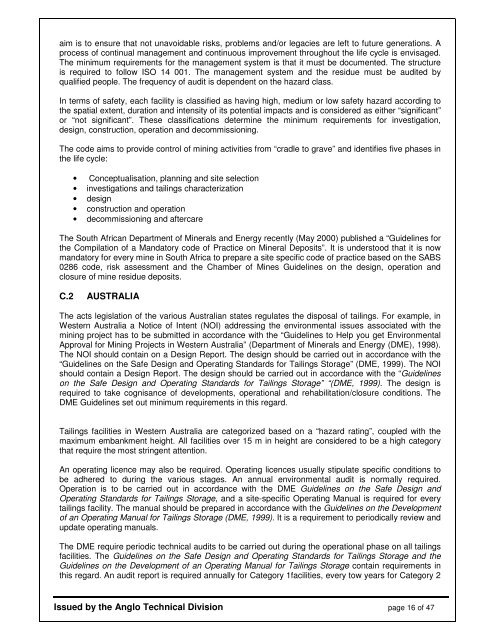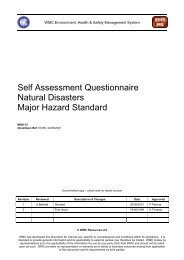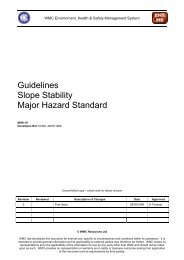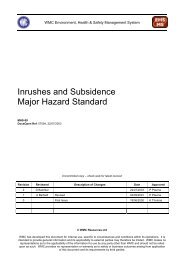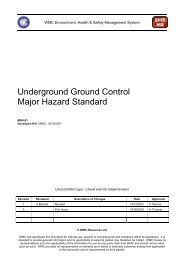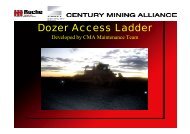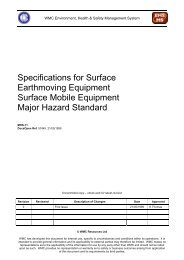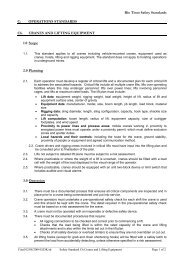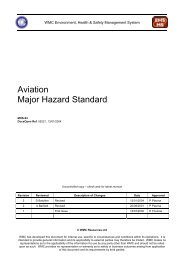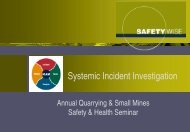SAFETY, HEALTH & ENVIRONMENT BULLETIN - MIRMgate
SAFETY, HEALTH & ENVIRONMENT BULLETIN - MIRMgate
SAFETY, HEALTH & ENVIRONMENT BULLETIN - MIRMgate
Create successful ePaper yourself
Turn your PDF publications into a flip-book with our unique Google optimized e-Paper software.
aim is to ensure that not unavoidable risks, problems and/or legacies are left to future generations. A<br />
process of continual management and continuous improvement throughout the life cycle is envisaged.<br />
The minimum requirements for the management system is that it must be documented. The structure<br />
is required to follow ISO 14 001. The management system and the residue must be audited by<br />
qualified people. The frequency of audit is dependent on the hazard class.<br />
In terms of safety, each facility is classified as having high, medium or low safety hazard according to<br />
the spatial extent, duration and intensity of its potential impacts and is considered as either “significant”<br />
or “not significant”. These classifications determine the minimum requirements for investigation,<br />
design, construction, operation and decommissioning.<br />
The code aims to provide control of mining activities from “cradle to grave” and identifies five phases in<br />
the life cycle:<br />
• Conceptualisation, planning and site selection<br />
• investigations and tailings characterization<br />
• design<br />
• construction and operation<br />
• decommissioning and aftercare<br />
The South African Department of Minerals and Energy recently (May 2000) published a “Guidelines for<br />
the Compilation of a Mandatory code of Practice on Mineral Deposits”. It is understood that it is now<br />
mandatory for every mine in South Africa to prepare a site specific code of practice based on the SABS<br />
0286 code, risk assessment and the Chamber of Mines Guidelines on the design, operation and<br />
closure of mine residue deposits.<br />
C.2 AUSTRALIA<br />
The acts legislation of the various Australian states regulates the disposal of tailings. For example, in<br />
Western Australia a Notice of Intent (NOI) addressing the environmental issues associated with the<br />
mining project has to be submitted in accordance with the “Guidelines to Help you get Environmental<br />
Approval for Mining Projects in Western Australia” (Department of Minerals and Energy (DME), 1998).<br />
The NOI should contain on a Design Report. The design should be carried out in accordance with the<br />
“Guidelines on the Safe Design and Operating Standards for Tailings Storage” (DME, 1999). The NOI<br />
should contain a Design Report. The design should be carried out in accordance with the “Guidelines<br />
on the Safe Design and Operating Standards for Tailings Storage” “(DME, 1999). The design is<br />
required to take cognisance of developments, operational and rehabilitation/closure conditions. The<br />
DME Guidelines set out minimum requirements in this regard.<br />
Tailings facilities in Western Australia are categorized based on a “hazard rating”, coupled with the<br />
maximum embankment height. All facilities over 15 m in height are considered to be a high category<br />
that require the most stringent attention.<br />
An operating licence may also be required. Operating licences usually stipulate specific conditions to<br />
be adhered to during the various stages. An annual environmental audit is normally required.<br />
Operation is to be carried out in accordance with the DME Guidelines on the Safe Design and<br />
Operating Standards for Tailings Storage, and a site-specific Operating Manual is required for every<br />
tailings facility. The manual should be prepared in accordance with the Guidelines on the Development<br />
of an Operating Manual for Tailings Storage (DME, 1999). It is a requirement to periodically review and<br />
update operating manuals.<br />
The DME require periodic technical audits to be carried out during the operational phase on all tailings<br />
facilities. The Guidelines on the Safe Design and Operating Standards for Tailings Storage and the<br />
Guidelines on the Development of an Operating Manual for Tailings Storage contain requirements in<br />
this regard. An audit report is required annually for Category 1facilities, every tow years for Category 2<br />
Issued by the Anglo Technical Division page 16 of 47


